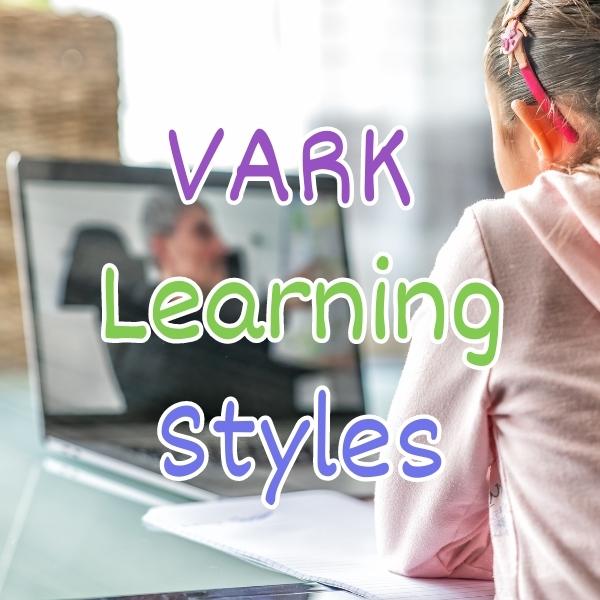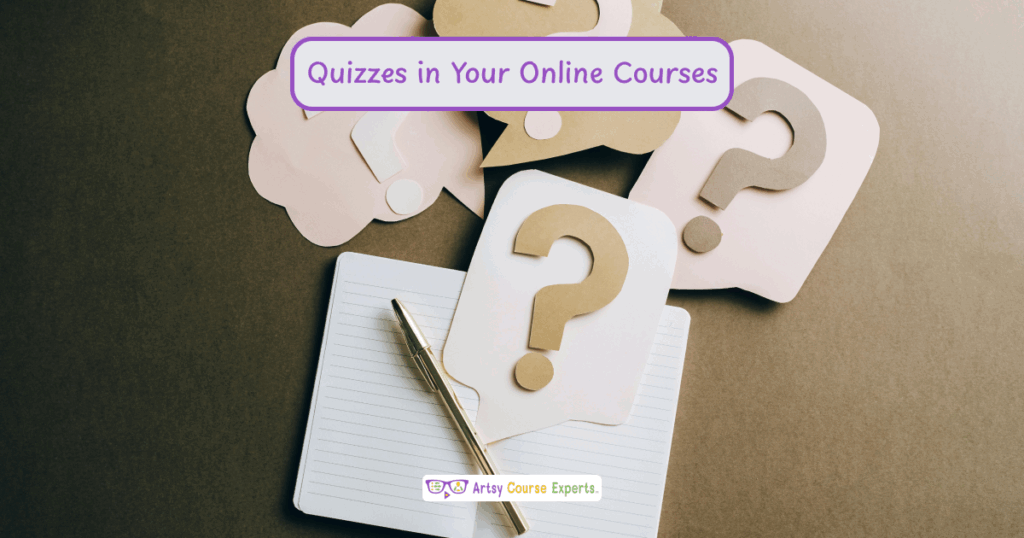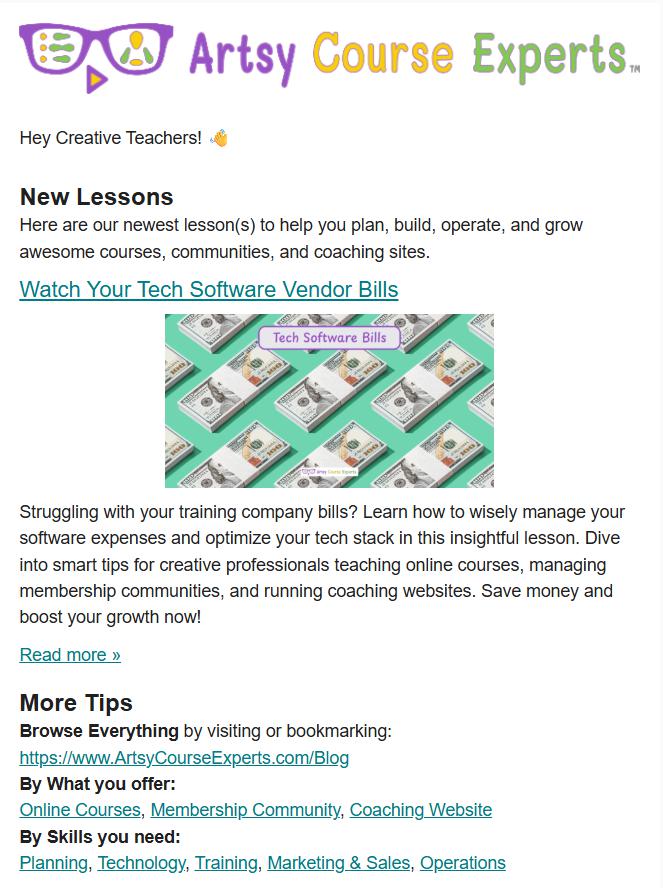Introduction
Have you ever wondered why some people learn more easily through visual aids while others prefer to listen to lectures or read textbooks? The VARK model of learning styles provides a useful framework for understanding how different people prefer to learn and process information.
In this lesson, we will explore four types of learning styles and provide tips so that you can teach your students using different kinds of learning techniques.
By learning how to teach with different learning styles, you can teach many different kinds of students who may have different strengths. For example, they might not be able to appreciate some of your content, or it may not work for their brain or their style because they have different kinds of learning styles.
Challenges that some online course teachers or students may encounter if they don’t leverage VARK learning styles could include:
- Students who do not connect with the teaching style may become disengaged and lose interest in the course.
- Students who do not receive information in their preferred learning style may have difficulty retaining and applying it to future coursework.
- Teachers who do not use various assessment methods may not be able to accurately measure how students understand the material.
- Students may feel overwhelmed or disconnected from the course and may be more likely to drop out or lose motivation to complete the course.
- Students who feel that their learning needs are not being met may provide negative feedback or reviews, which can damage the reputation of the course and the teacher.
Video Lesson – How To Teach Your Students Using Different VARK Learning Styles
Who Can Benefit From VARK Learning Styles
Using various teaching methods that cater to different learning styles helps creative educators produce a more inclusive and engaging learning environment that supports all students learning needs. Here are a few examples of course creators that can teach better using the VARK learning styles:
- Fashion designers can use visual aids such as sketches, mood boards, and fashion illustrations to help visual learners understand the design process. Auditory learners may benefit from verbal explanations of design concepts, while reading/writing learners may prefer to read fashion history books and write about their design inspirations. Kinesthetic learners may benefit from hands-on activities like pattern-making and garment construction.
- Graphic designers can use visual aids such as infographics, diagrams, and typography to help visual learners understand design principles. Auditory learners may benefit from listening to design critiques and participating in group discussions. Reading/writing learners may prefer to read design theory books and write about their design process. Kinesthetic learners may benefit from hands-on activities such as sketching and prototyping.
- Writers can use visual aids such as storyboards, mind maps, and character sketches to help visual learners understand the writing process. Auditory learners may benefit from listening to readings and participating in writing workshops. Reading/writing learners may prefer to read literature books and write about their writing process. Kinesthetic learners may benefit from hands-on activities such as writing prompts and collaborative writing exercises.
- Sculptors can use visual aids such as sketches, 3D models, and sculptures to help visual learners understand sculpting techniques. Auditory learners may benefit from listening to lectures on art history and sculpture techniques. Reading/writing learners may prefer to read sculpture theory books and write about their sculpting process. Kinesthetic learners may benefit from hands-on activities such as clay modeling and sculpture workshops.
- Art teachers teaching anime cartoon styles can use the VARK learning styles to identify the learning preferences of their students and adjust their teaching methods accordingly, such as using visual aids for visual learners or group activities for kinesthetic learners.

The Four VARK Learning Styles
Developed by Neil Fleming in the late 1980s, VARK is an acronym for Visual, Auditory/Audio, Reading/Writing, and Kinesthetic learning styles. Each style is called a modality that students prefer to learn. With VARK learning styles, you’ll learn some techniques to help you become a better online course teacher.
Understanding the preferred learning styles for your students can help you tailor your learning approach and improve your learning outcomes. However, it’s important to note that most people have a combination of learning styles and may benefit from various teaching methods.
Visual
These are students who love to see, watch, and learn using their eyes. Visual learners prefer to learn through visual aids such as diagrams, charts, and videos. These students prefer seeing pictures, visualizing, and looking at all the little aesthetic details.
They tend to remember information better when it is presented to them visually. So as a teacher, you should be using pictures or flow charts or animations, or even movies or demonstrations. They want to see how to do a certain thing to learn.
Aural
Aural or auditory students learn by listening and by hearing the teacher. They want to listen to the teacher summarize, explain, and discuss the different examples. For these kinds of students, as a teacher, you’ll teach by lecturing or even having discussion groups, chats, or small groups.
You might use a podcast or some audio show format where you’re explaining clearly and using your words to provide extra details. You might even use music and sound effects at different points to catch their attention and move them through the different steps or lessons, topics or chunks that you’re trying to teach.
Reading & Writing
These are students that love words. They want to read books, get extra resources, see definitions, and process by writing what they hear.
As a teacher, you’ll assign reading, provide answers, let the students write out answers, provide them with questions, and let them write them out, mark up, use notes, and highlight. They will be reading assignments, processing them, writing them in their own words, and summarizing each of the chunks.
They might be creating lists or little blocks of collections of words. Those students need the words and their own alone time. They have to zone in and focus on the difference, process it, and rewrite it with notes. That’s the third category, the reading and writing students.
Kinesthetic
These students learn by doing. They like activities and want to perform tasks; they want to manipulate objects, touch things, position things, and maybe do movement, if it’s some dance or a maker or something like that.
To teach these students, you want to use hands-on experiences and hands-on exercises. They want to work with physical materials and follow along. They want to see you, copying you as you show them different lessons.
So they’re watching you, copying you, moving their hands, or moving a piece of hardware. If it’s like a sewing machine or a soldering iron, whatever it is, they want to learn while watching you, and they want to do it. That’s how they’ll learn. They learn by doing.
Multiple Styles
While the VARK model has these four kinds of learning styles – Visual, Aural, Reading and Writing, and Kinesthetic.
You’ll also want to think about that most people are not just one type of learner, but might have two, or three different preferred modalities.
So as you create and teach content, think about several different kinds of ways that you can teach your content in order to appeal to the many different kinds of learners that are out there.
How Online Teachers Can Teach Using VARK Learning Styles
Let’s go into an example and think about the different ways that, as an online teacher, or a coach, you can help your students with a wide range of modalities.
Visual
If you’re thinking about helping visual learners, you’ll want pretty slides, flow charts, and diagrams. You might even include something visual, even if you teach them music. You might have sheet music, example videos, and even leverage multiple cameras.
Depending on what you’re teaching, if you’re teaching fashion or how to sew, handbags or whatever, or, maybe, you’re playing the drums, you may want multiple cameras so that they can appreciate, see and take in all the different angles.
Audio
You’ll need to leverage all the teaching techniques, like potentially speaking slowly or breaking out lessons. You’ll also leverage metaphors and similes, acronyms, mnemonics, etc. You might have some intro and outro music, or even an intro and outro, where you’re orienting them, you’re teaching them, and then you’re summarizing at the end.
These are all really good techniques for students that are listening. They’re watching you, but for them, it’s all about what you’re saying.
Reading & Writing
These students want rich decks, PowerPoints, slides, and keynotes. They’ll want you to chunk those slides into different blocks. They’ll want to see bulleted lists and supplemental information like eBooks and quizzes, or PDF resources and highlight or mark up some content. So give them something to print out and follow along.
Maybe as you’re going over the lesson, there are these handouts, and they have these prompts that they can fill in. They can add notes and annotate as well as these students probably have their notes. That’s how you’ll support the students who prefer to learn through reading and writing.
Kinesthetic
Finally, you have kinesthetic learners. You’ll need to make demonstration videos, not just teaching them, but you’ll show them how you’re doing stuff by using prop samples. You’ll give them the assignment to make something and even do a show and tell them to submit it to fellow students or you.
So as the master teacher and course coach, you can review them depending on their phase and give them feedback. You might even want to use an external environment or a different set, or different shots, like your camera not being zoomed on you but zoomed on your hands as you’re teaching them these different things.
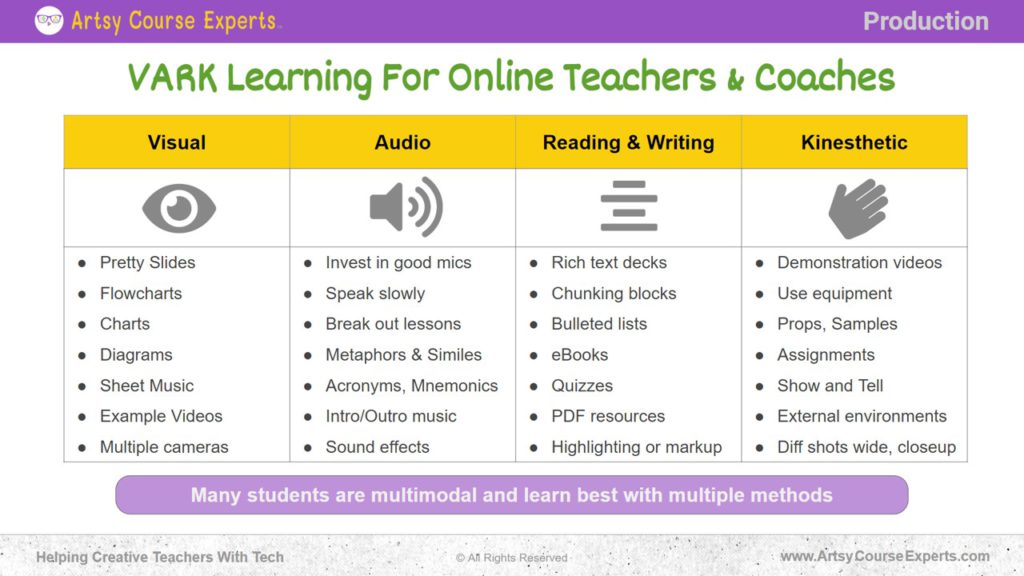
Frequently Asked Questions About VARK
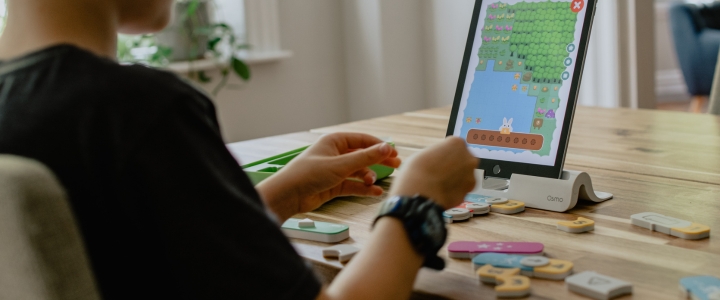
Summary
Understanding the VARK learning style model can be an incredibly valuable tool for educators in creative fields to improve their teaching outcomes. By recognizing and catering to the different learning styles of their students, online course teachers can create engaging and effective learning experiences that benefit all learners.
If you want to level up, review your curriculum and think about how exactly are you going to teach each one of your different modules. If you want to go further, you can go lesson by lesson, and you can think about how you’ll use certain different teaching techniques for each of your lessons. You can even document this as you’re brainstorming your content, you can have a note or column that includes how modalities.
Tips for online course creators to leverage the VARK learning styles:
- Use a variety of teaching methods since many students are multimodal and learn best via multiple methods.
- As a teacher, you yourself may have your preferred modes, but think about 2 to 3 modes that work best for your broad student base.
- Plan and document which V.A.R.K. techniques you will use for each modules and lesson.
- Provide an audio recording of a lecture for auditory learners while providing a transcript for reading/writing learners.
- Use various assessment methods like quizzes for reading/writing learners while incorporating group projects for kinesthetic learners.
- Create additional resources to round out your primary video teaching techniques.
You should be a little smarter now. Thanks for hanging out!
Please subscribe to get more tips for creative online course teachers.
More Tips For Online Teachers
These lessons can also help you with Curriculum and Production:
- Artificial Intelligence for Course Creators
- Using The ADDIE Model To Design Effective Online Courses
- Increase Student Confidence With the Theory of Multiple Intelligences
- Bloom’s Taxonomy for Creative Teachers
- Microlearning – Teaching One Small Thing Per Lesson

